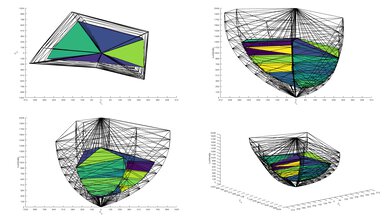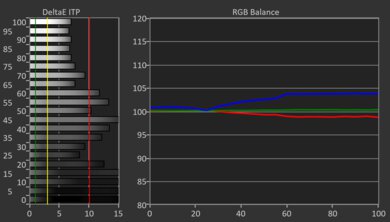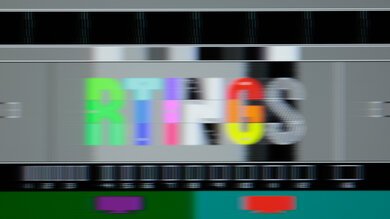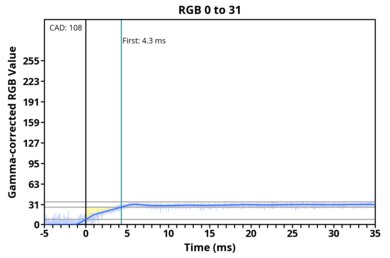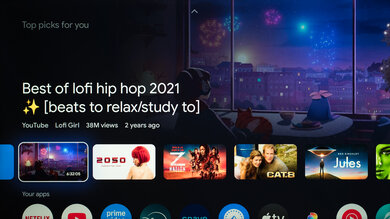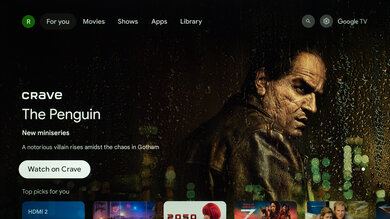The Hisense QD7N is a budget model in Hisense's 2024 entry-level QLED lineup and sits above the Hisense QD65NF. Unlike Hisense's popular U-Series, you won't find local dimming on this model, and it uses an IPS panel. The TV still has advanced gaming features like HDMI 2.1 bandwidth, 4k @ 144Hz, 1080p @ 240Hz, and VRR. It also supports Dolby Vision, Dolby Atmos, and DTS audio formats. The TV has a built-in 20W 2.0 channel speaker system, runs the popular Google TV OS that's loaded with apps and smart features like voice control, and works with Alexa and Apple HomeKit. We bought and tested the 65-inch model, but it's available in four sizes total: 65, 75, 85, and 100 inches.
Our Verdict
The Hisense QD7 is inadequate for mixed usage. It looks very underwhelming in a dark room due to its terrible black levels. Additionally, HDR content is unimpressive since the TV isn't bright enough for a proper HDR viewing experience. The TV is bright enough to handle glare in a moderately lit room, but it doesn't have the reflection handling or brightness needed for a well-lit room. Fortunately, the TV has modern gaming features that make it a decent pairing with modern consoles if you care more about performance than image quality. Another positive is that the TV's viewing angle is good enough if you're viewing the screen from an angle.
Good viewing angle.
Terrible contrast means blacks are gray most of the time.
Too dim in HDR for highlights to stand out.
Direct reflections are very visible on the screen.
The Hisense QD7 is inadequate for a home theater. The TV's black levels are terrible, so blacks look gray during most scenes, and the image looks washed out. The TV doesn't have the HDR color volume needed to make dark colors look rich, and bright colors are dim. Its HDR peak brightness is sub-par, so highlights don't stand out like they should, and HDR content really lacks impact on this TV. Fortunately, the TV does a very good job cleaning up artifacts in low-quality content, and low-resolution content is upscaled well enough that the image doesn't look soft, so most SDR content looks decent on this model.
Removes judder from all sources.
Good upscaling and very good low-quality content smoothing.
Excellent pre-calibration SDR color accuracy.
Terrible contrast means blacks are gray most of the time.
Too dim in HDR for highlights to stand out.
Poor PQ EOTF tracking means the brightness of HDR content isn't accurate.
The Hisense QD7 is okay for use in a bright room. The TV's SDR brightness is good enough to handle glare in a moderately lit room, but it's not bright enough for more well-lit environments. Furthermore, mirror-like reflections caused by light sources directly facing the screen are distracting. Fortunately, black levels are barely elevated, and colors don't lose saturation in a bright room, so the TV's image quality doesn't take a hit when you have your lights on.
Black levels and color saturation are barely affected by lighting.
Direct reflections are very visible on the screen.
The Hisense QD7 is adequate for watching sports. It's bright enough to fight glare in a moderately lit room, but direct reflections are visible on the screen, so it's best to avoid placing the TV directly in front of any light sources. It does a good job upscaling content, and a very good job cleaning up artifacts in low-quality cable feeds, so you don't have to watch a soft or noisy image. Unfortunately, the TV's uniformity is middling: the edges of the screen are darker than the rest, and there's noticeable direct screen effect towards the middle. Thankfully, the TV's viewing angle is good enough that the image isn't severely degraded when watching from an angle.
Good upscaling and very good low-quality content smoothing.
Excellent pre-calibration SDR color accuracy.
Good viewing angle.
Noticeable uniformity issues in brighter content.
Direct reflections are very visible on the screen.
The Hisense QD7 is a sub-par gaming TV. It has HDMI 2.1 bandwidth, up to 4k @ 144Hz, and VRR, so it has solid compatibility with consoles. However, the TV's pixel response times are very slow, so fast motion looks blurry and lacks sharpness. Even though the TV has modern gaming features, its image quality is inadequate if you're looking for a screen to make your games look as good as possible due to its terrible black levels and low peak brightness.
HDMI 2.1 bandwidth, 4k @ 144Hz, 1080p @ 240Hz, and VRR support.
Low input lag for a responsive experience.
Terrible contrast means blacks are gray most of the time.
Too dim in HDR for highlights to stand out.
VRR doesn't work in 1080p @ 240Hz.
Very slow pixel response times leads to blurry motion.
The Hisense QD7 has middling brightness. Its SDR brightness is okay, so it's bright enough to handle glare in moderately lit rooms. Unfortunately, its HDR brightness is sub-par, so highlights and bright scenes don't stand out like they should in HDR content.
Too dim in HDR for highlights to stand out.
The Hisense QD7 has terrible black levels. Its contrast is very bad, so blacks look gray during most scenes, making the image look flat and washed out. Furthermore, its black uniformity is inadequate, so dark scenes are noticeably cloudy.
Terrible contrast means blacks are gray most of the time.
Inadequate black uniformity leads to cloudiness during dark scenes.
The Hisense QD7 has decent colors overall. The TV has excellent SDR color accuracy out of the box, so it stays true to the filmmaker's intent. Furthermore, its SDR color volume is good, so most SDR content doesn't look muted. On the other hand, its HDR color volume is only alright; dark colors lack depth, and it's too dim to display very bright colors. Sadly, its HDR color accuracy is unremarkable, so the TV requires calibration if you care about color accuracy in HDR, which kind of defeats the purpose of going with a cheap model like this.
Excellent pre-calibration SDR color accuracy.
Note: We're in the process of improving our tests related to image processing, but this score should give you a general idea of how a TV performs overall with its image processing capabilities.
The Hisense QD7 has decent processing capabilities. It does a good job upscaling, so low-resolution content looks sharp enough that details are still present. Furthermore, the TV's very good low-quality content smoothing means artifacts are cleaned up well in heavily compressed content. HDR color gradients are mostly free from distracting banding. However, the TV has poor PQ EOTF tracking, so HDR content isn't displayed at the brightness level that the filmmaker intends.
Good upscaling and very good low-quality content smoothing.
Minimal banding in color gradients.
Poor PQ EOTF tracking means the brightness of HDR content isn't accurate.
The Hisense QD7 has okay responsiveness in its dedicated gaming mode. It has modern gaming features like HDMI 2.1 bandwidth, up to 4k @ 144Hz, and VRR, which is great for a cheap model. Its input lag is quite low, especially at higher refresh rates, so gaming feels responsive. Sadly, the TV has very slow pixel response times, so fast motion is blurry and lacks clarity, which really holds back the TV's gaming performance.
HDMI 2.1 bandwidth, 4k @ 144Hz, 1080p @ 240Hz, and VRR support.
Low input lag for a responsive experience.
VRR doesn't work in 1080p @ 240Hz.
Very slow pixel response times leads to blurry motion.
We're in the process of fixing the way we evaluate a TV's overall motion handling. This section is currently broken, and the score isn't indicative of how well a TV handles motion overall.
Performance Usages
Changelog
-
Updated Nov 21, 2025:
Mentioned the newly reviewed Hisense 98QD5QG in the Stutter section.
-
Updated Nov 12, 2025:
We bought and tested the TCL QM5K and added a comparison in the Contrast section of the review.
-
Updated Oct 14, 2025:
We bought and tested the TCL Q77K and added a comparison in the Contrast section.
- Updated Sep 24, 2025: Converted to Test Bench 2.0.1. We did this to fix an issue with our scoring in the Supported Resolutions section, since TVs with a refresh rate higher than 144Hz were being penalized for not supporting 144Hz.
Check Price
Differences Between Sizes And Variants
We bought and tested the 65-inch Hisense QD7N, and the results are also valid for the 75, 85, and 100-inch models. Costco sells an 85-inch variant of the TV in the US known as the Hisense QD75N, but it performs the same and comes with an extended warranty and other store-specific perks.
| Size | Model | Costco Variant |
|---|---|---|
| 65" | Hisense 65QD7N | - |
| 75" | Hisense 75QD7N | - |
| 85" | Hisense 85QD7N | Hisense 85QD75N |
| 100" | Hisense 100QD7N | - |
Our unit was manufactured in May 2024.
Popular TV Comparisons
The Hisense QD7N is a sub-par TV overall. It's a decent option if you're specifically looking for a cheap TV to pair with your Xbox Series X, PS5, or Switch 2, since it's one of the cheapest TVs to feature modern gaming features like HDMI 2.1 bandwidth, 4k @ 144Hz, and VRR, similar to the TCL Q77K. It even gives you the option to lower your resolution for a higher frame rate since it supports 1080p @ 240Hz, but unfortunately, VRR doesn't work when you do that. On the other hand, its overall picture quality leaves a lot to be desired. If you want modern gaming features but still want a model that has good image quality, you're much better off spending a bit more on the Hisense U65QF or the TCL QM6K.
For more options, check out our recommendations for the best TVs under $1,000, the best TVs for gaming, and the best TVs for watching movies. To learn more about the tests we do that inform our scores and recommendations, check out our article on how we test TVs.
The Hisense U65QF is a better TV than the Hisense QD7N. The U65QF has significantly better black levels due to its local dimming feature, giving the image more depth. The U65QF is also more suitable for bright rooms thanks to its superior SDR brightness, and its 144Hz supports makes it a better option for PC gamers.
The Hisense U75QG is in a completely different league when compared to the Hisense QD7N. The U75QG is far brighter, has way better black levels due to its local dimming feature, is capable of gaming at 4k @ 165Hz or 1080p @ 288Hz, and looks way more colorful.
The Hisense QD7N is better overall than the Hisense QD65NF, but it sits at a higher price point. The QD6 has a better native contrast ratio than the QD7, but the QD7 gets brighter and offers more features, especially for gamers, including HDMI 2.1 bandwidth and VRR.
The TCL QM6K is significantly better than the Hisense QD7N. The TCL delivers a significantly better dark room experience thanks to its higher native contrast ratio and Mini LED local dimming. It's also considerably brighter, and small specular highlights in HDR stand out better. Both TVs offer an impressive array of gaming features, but the TCL is the better choice, as it supports a higher refresh rate at lower resolutions.

We buy and test dozens of TVs yearly, taking an objective, data-driven approach to deliver results you can trust. Our testing process is complex, with hundreds of individual tests that take over a week to complete. Most of our tests are done with specially designed test patterns that mimic real content, but we also use the same sources you have at home to ensure our results match the real-world experience. We use two main tools for our testing: a Colorimetry Research CR-100 colorimeter and a CR-250 spectroradiometer.
Test Results

The Hisense QD7 has sub-par HDR brightness. Unfortunately, highlights don't stand out during most scenes due to the TV's terrible contrast, so HDR content lacks impact.
These measurements are after calibrating the HDR white point with the following settings:
- HDR Picture Mode: Filmmaker Mode
- Brightness: 100
- Contrast: 50
- Black Level: 0
- Dark Detail: Off
- Gamma: ST2084
- Active Contrast: Off
- Dynamic Tone Mapping: Off
- Color Temperature: Warm 1
Results with Dynamic Tone Mapping set to 'On':
- Hallway Lights: 379 cd/m²
- Yellow Skyscraper: 317 cd/m²
- Landscape Pool: 248 cd/m²
There's no noticeable difference in HDR brightness when the TV is set to PC/Game Mode.
These measurements are after calibrating the HDR white point with the following settings:
- HDR Picture Mode: HDR Game
- Brightness: 100
- Contrast: 50
- Black Level: 0
- Dark Detail: Off
- Gamma: ST2084
- Active Contrast: Off
- Dynamic Tone Mapping: Off
- Color Temperature: Warm 1
Results with Dynamic Tone Mapping set to 'On':
- Hallway Lights: 374 cd/m²
- Yellow Skyscraper: 318 cd/m²
- Landscape Pool: 249 cd/m²
The Hisense QD7 has okay SDR brightness, and it overcomes glare from indirect lighting in moderately lit rooms.
These measurements are after calibration with the following settings:
- Picture Mode: Theater Night
- Brightness: 100
- Gamma: 2.2
- Color Temperature: Warm 1
- Active Contrast: Off
The Hisense QD7 has terrible contrast, even compared to cheaper models like the Hisense QD65NF. Blacks are raised and look gray when any highlights are also on the screen, and the TV lacks a local dimming feature to improve its contrast. If you want similar gaming features with better contrast, look at the TCL Q77K or the TCL QM5K instead.
This TV doesn't have a local dimming feature, so it doesn't adjust the backlight of individual areas to brighten up highlights without impacting the rest of the image. This means that there are no distracting flickers or brightness changes as bright highlights move across the screen.
The Hisense QD7 has good SDR color volume. Like almost any modern TV, it covers the entire range of colors in the BT.709 color space used by most SDR content. It also has great coverage of the wider DCI-P3 color space, but its coverage of the widest BT.2020 color space is mediocre.
| Volume ΔE³ | DCI-P3 Coverage |
BT.2020 Coverage |
|---|---|---|
| L10 | 80.35% | 52.93% |
| L20 | 89.91% | 59.80% |
| L30 | 91.92% | 62.26% |
| L40 | 92.44% | 65.55% |
| L50 | 92.49% | 67.58% |
| L60 | 91.50% | 66.15% |
| L70 | 89.50% | 57.69% |
| L80 | 89.26% | 55.04% |
| L90 | 89.55% | 55.45% |
| L100 | 90.97% | 63.47% |
| Total | 90.72% | 61.11% |
The TV's HDR color volume is alright overall, but it doesn't display darker colors well due to its terrible contrast, and it doesn't display vibrant colors very brightly.
The TV has excellent pre-calibration SDR accuracy. Blues are slightly overrepresented in most grays, while reds are a bit underrepresented, which makes the TV's color temperature a little cooler than the 6500K we aim for. The color accuracy is fantastic, with only minor inaccuracies in whites, light yellows, magentas, and more saturated reds. Gamma is very close to 2.2, with only dark scenes and bright scenes being displayed a bit too brightly.
The TV has outstanding SDR accuracy after calibration. The white balance is now close to perfect, so the color temperature is almost exactly at 6500K. The color accuracy is even better, with only reds being slightly too saturated. Gamma is even closer to 2.2, but dark scenes are still displayed too brightly.
See our full calibration settings.
The TV has unremarkable HDR pre-calibration color accuracy. There's too much blue in most shades of gray, which contributes to the TV's very cool color temperature. The TV's overall color accuracy is alright, but there are mapping errors in most colors.
The Hisense QD7 has poor PQ EOTF tracking overall. Blacks and shadows are displayed brighter than intended. Most mid-tones are displayed a little bit brighter than intended, and there's also a dip with brighter mid-tones and some highlights that make them darker than intended. With content mastered at all nit levels, there's a gradual roll-off to maintain detail in highlights that are brighter than the TV's capabilities.
The Hisense QD7 does a good job at upscaling low-resolution content like DVDs or lower-resolution streams. Details are clear enough, but finer details are hard to make out.
Sharpness processing was calibrated with no over-sharpening for low-resolution content, with the following settings:
- Sharpness: 13
- Super Resolution: On
The TV has good HDR gradient handling. There's noticeable banding in dark grays, dark greens, and dark blues, but all other colors have minimal banding or no banding at all.
This TV has low input lag when set to PC/Game Mode, which ensures a very responsive gaming experience with very little delay between your actions with your controller or mouse and the action on-screen. In 1080p @ 240Hz, the input lag is 2.8 ms.
Unfortunately, a random bug causes higher-than-expected input lag in 1080p @ 240Hz. To fix this, you must power cycle the TV and your PC.
The TV supports all common resolutions up to 4k @ 144Hz on two of its four HDMI ports. Unfortunately, 1080p @ 240Hz only works properly with VRR disabled.
The TV supports all three VRR formats, so it has great compatibility regardless of the source. Unfortunately, with 1080p @ 240Hz and VRR enabled, the TV's built-in frame counter shows 72Hz, and there's bad frame skipping and desaturated colors, and chroma 4:4:4 isn't displayed properly. With VRR disabled, 1080p @ 240Hz works without issues.
Unfortunately, pixel response times at 144Hz on this TV are disappointing. There's very little overshoot, but transitions are slow, resulting in blurry motion overall. It's worse in blacks and near-blacks, resulting in more blur in dark scenes.
The TV is fully compatible with everything the PS5 offers, like 1440p @ 120Hz and 4k @ 120Hz, as well as HDMI Forum VRR. It also supports Auto Low Latency Mode, so you don't have to worry about manually switching to PC/Game Mode to get the lowest input lag.
The TV is fully compatible with everything the Xbox Series X|S offers, including 1440p @ 120Hz, 4k @ 120Hz, HDMI Forum VRR, FreeSync Premium Pro, and Dolby Vision gaming. It also supports Auto Low Latency Mode, so you don't have to worry about manually switching to PC/Game Mode to get the lowest input lag.
Due to the TV's relatively quick response time, there's some minor stutter when watching movies or TV shows, and it's most apparent in slow-panning shots. For better stutter performance, you need a TV with a slower response time, such as the Hisense 98QD5QG.
The TV gives a judder-free experience from any source with the 'Motion Enhancement: Film' setting turned on.
The TV uses pulse width modulation (PWM) to dim its backlight, which introduces flicker that can bother people who are sensitive to it. The TV flickers at 240Hz in all picture modes with the brightness set at '99' or below, which is slow enough to bother people who are sensitive to flicker. Fortunately, the TV flickers at an incredibly fast 90,000Hz (90kHz) with the brightness set to maximum, which isn't noticeable.
The TV doesn't have an optional backlight strobing feature, commonly known as black frame insertion (BFI), to help reduce persistence blur.
This TV has an optional motion interpolation feature to improve the clarity of motion. It works well with slower-moving scenes. In faster-moving scenes, the TV struggles, and there are distracting artifacts and some minor image duplication.
The Hisense QD7 has sub-par direct reflection handling. The glossy coating does very little to reduce the intensity of bright, mirror-like reflections from lights or windows.
There's only some minor black level raise in a room with ambient lighting, so blacks look similar as they do in a dark room.
The TV's perceived color volume in a bright room is alright. Ambient light has little impact on the total color volume, but it's low to begin with.
The Hisense QD7 has a good viewing angle. The image looks mostly consistent from a slight angle, but there's brightness loss, gamma shifting, and color washout that becomes worse the further you move off-center. Its viewing angle is wider than many other LED TVs, but the image is noticeably degraded at aggressive angles.
The Hisense QD7 has middling gray uniformity. The sides of the screen are a lot darker than the middle, and there's noticeable dirty screen effect towards the center of the screen. On a very dark or near-black screen, its uniformity is good.
The TV has HDMI 2.1 bandwidth on HDMI ports 3 and 4, with both supporting up to 4k @ 144Hz. HDMI 1 is the eARC port, so you don't lose a high-bandwidth port when you plug a soundbar into the TV.
The TV supports eARC, which lets you pass high-quality, uncompressed audio to a compatible receiver or soundbar through an HDMI cable. It supports all major audio formats, so you don't have to worry about compatibility with external sources.
The top section of the TV is metallic, and the section that houses the inputs is made of plastic. Most of the inputs are side-facing, but they're located towards the middle of the TV, making them hard to reach when the TV is wall-mounted. The Ethernet, digital audio out, and the USB port located on the back are inaccessible if you have it mounted flush to the wall. Unfortunately, the TV doesn't come with any clips to help with cable management.
The TV's build quality is alright. It wobbles a bit on its feet when pushed on, and there's some minor flexing on the back, but this is to be expected and doesn't cause issues. Unfortunately, our unit has a bulge that slightly separates the glass from the LCD.
There's a single button on the bottom center of the TV that can be used to switch inputs and power the TV on/off. There's also a small switch that you can use to turn on/off the TV's built-in microphone.
The Hisense QD7 has a mediocre frequency response. Like most TVs, it barely produces any bass. The sound is well-balanced at moderate volume levels, making dialogue easy to understand. Unfortunately, the sound becomes unbalanced near and at maximum volume, which is unfortunate since the TV doesn't get very loud.














